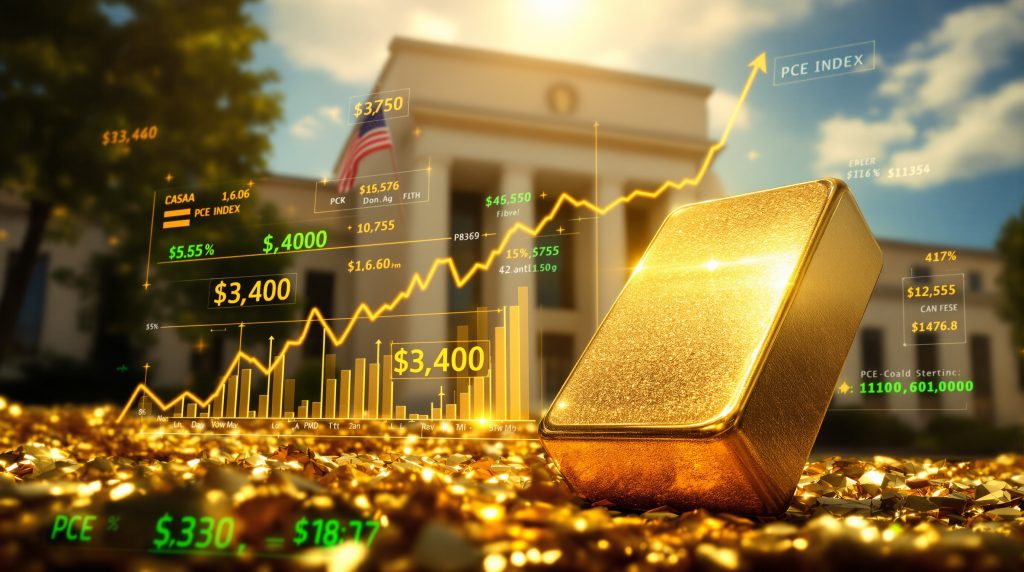Gold Prices Await U.S. Economic Data: Market Analysis and Investment Outlook
Gold has maintained stable trading near $2,075 per ounce, recently touching its highest level since mid-August. This stability comes as investors exercise caution ahead of crucial U.S. economic data releases that could influence Federal Reserve monetary policy decisions.
Current Gold Price Movements
Spot gold is holding steady around $2,075 per ounce as of the latest trading session, reflecting market hesitation ahead of key economic indicators. U.S. gold futures for near-term delivery are trading in a narrow range, showing the market's cautious positioning.
Gold prices continue to hover near important psychological thresholds, with the precious metal maintaining impressive year-to-date gains of approximately 12-15% in the current calendar year.
Market participants are closely monitoring price action for signals of the next directional move, with technical analysts noting potential support and resistance levels that could influence short-term trading patterns.
Market Sentiment Indicators
Institutional investors have shown increased interest in gold assets throughout recent months, with fund flows into gold-backed ETFs turning positive after previous outflows.
Trading volumes indicate cautious positioning ahead of upcoming economic data releases, with many participants reducing position sizes while maintaining overall directional bias.
Technical analysis suggests potential for further upward movement if certain resistance levels are broken, particularly if economic data supports expectations of Federal Reserve monetary easing.
Despite short-term hesitation, market participants generally maintain a bullish outlook on gold, supported by macroeconomic uncertainty and geopolitical tensions.
Why Are Investors Closely Watching U.S. Economic Data?
The upcoming Personal Consumption Expenditures (PCE) Price Index release has captured market attention as it represents the Federal Reserve's preferred inflation gauge. This data point could significantly influence monetary policy decisions in the coming months.
Significance of the PCE Price Index
The PCE Price Index is scheduled for release on the final Friday of the month and serves as the Federal Reserve's primary inflation measure for policy decisions.
Economists are projecting a moderate year-over-year increase, with particular attention paid to the core measurement that excludes volatile food and energy components.
The previous month's reading showed an annual increase that remained above the Fed's 2% target, though the pace of inflation has been gradually moderating.
Core PCE data is particularly important for Fed decision-making as it provides insight into underlying inflation trends that influence longer-term monetary policy considerations.
Impact on Federal Reserve Policy Expectations
Markets are currently pricing in high probability of a rate cut in upcoming Fed meetings, with futures markets reflecting these expectations through interest rate derivatives.
Economic data strength or weakness will help determine not only the timing but also the pace of future rate adjustments, with weaker data potentially accelerating the easing cycle.
Fed officials have been signaling openness to rate cuts while emphasizing data dependency in their public communications, carefully managing market expectations.
There is significant potential for surprise readings to shift market expectations regarding both the timing and magnitude of potential rate adjustments.
How Do Interest Rate Expectations Influence Gold Prices?
Gold typically performs well in low-interest-rate environments due to its non-yielding nature. Current market conditions and Fed communications are creating a favorable backdrop for the precious metal.
Federal Reserve Policy Outlook
Regional Fed presidents have been indicating the likelihood of future rate reductions, though the timing and pace remain dependent on incoming economic data.
Policymakers continue to emphasize the need for additional economic evidence before making definitive decisions on monetary policy adjustments.
Market participants increasingly anticipate the beginning of a rate-cutting cycle, with debate centered on whether the initial cut will be standard or more aggressive.
The ongoing discussion about the size and pace of potential rate reductions creates market volatility that often benefits gold as a perceived safe-haven asset.
Gold's Relationship with Interest Rates
Lower interest rates reduce the opportunity cost of holding non-yielding assets like gold, as the relative disadvantage of owning gold versus interest-bearing securities diminishes.
Rate cut expectations are supporting current gold price forecast levels, with the metal often pricing in monetary policy changes before they actually occur.
Historical performance analysis shows gold strength during monetary easing cycles, with the metal averaging gains of 15-20% during the first 12 months of Fed easing cycles since 2000.
Forward interest rate projections from major financial institutions create positive sentiment for precious metals, as declining real yields typically correlate with higher gold prices.
What Fundamental Factors Are Driving Gold's Current Performance?
Multiple fundamental drivers are converging to support gold prices, creating what analysts describe as favorable conditions for continued strength in the precious metal market.
Institutional Trust and Central Bank Independence
Market analyst Kyle Rodda of Capital.com notes that "We've got a lot of positive interest for gold because of that sort of issues with institutional trusts and risks about Fed's independence." This highlights growing concerns about institutional stability influencing safe-haven demand.
Questions regarding central bank independence amid political pressures have emerged as a significant factor in gold's appeal, particularly in an election year environment.
Geopolitical tensions across multiple regions continue to add to gold's appeal as a crisis hedge, with ongoing conflicts creating persistent uncertainty.
Diversification strategies among institutional investors have led to increased gold allocations, particularly as correlations between traditional asset classes have strengthened.
Central Bank Purchasing Trends
Global central banks continue to add gold to foreign exchange reserves, with quarterly buying remaining above historical averages according to World Gold Council data.
Diversification away from traditional currency reserves has supported persistent demand, particularly as concerns about currency debasement remain prevalent.
Emerging market central banks have been particularly active in gold accumulation, seeking to reduce dependence on dollar-denominated assets.
Strategic reserve positioning creates consistent buying pressure that provides a price floor during periods of market weakness.
Investment Product Flows
After periods of outflows, gold-backed exchange-traded funds (ETFs) have recently seen renewed investor interest, reflecting changing market sentiment.
Institutional investors have been increasing portfolio allocations to precious metals, often citing inflation protection and diversification benefits.
Retail investment demand has shown resilience despite high price levels, with coin and small bar purchases remaining robust in many markets.
Market data indicates sustained buying interest across multiple investor categories, creating broad-based support for record-high gold prices.
How Are Other Precious Metals Performing?
While gold captures most market attention, other precious metals are showing varied performance patterns that provide additional context for the broader metals market.
Silver Market Dynamics
Spot silver has been trading with higher volatility than gold, typical of its smaller market size and dual industrial-investment characteristics.
Industrial demand is supporting silver alongside investment interest, with renewable energy applications particularly significant for future consumption.
The gold-to-silver ratio provides insight into relative valuation metrics, with current readings offering clues about potential outperformance.
Price momentum in silver has occasionally shown stronger percentage moves than gold in recent trading sessions, reflecting its historical tendency toward higher beta.
Platinum Group Metals Trends
Platinum prices have stabilized after previous weakness, with the metal maintaining its significant discount to gold – a relationship that has persisted since 2015.
Palladium continues to experience price pressure from automotive sector transitions, as electric vehicle growth reduces demand for traditional catalytic converters.
Industrial applications create significantly different demand dynamics for platinum group metals compared to gold, making them less sensitive to monetary policy shifts.
Automotive sector recovery efforts influence platinum group metals performance, with vehicle production rates serving as key indicators for price direction.
What Technical Analysis Indicators Are Gold Traders Watching?
Technical factors play an important role in short-term price movements, with several key levels and indicators currently influencing market sentiment.
Key Price Levels and Resistance Points
Round psychological numbers often serve as significant resistance points, with traders paying particular attention to century marks on price charts.
Previous monthly highs provide important technical reference points, with breakouts above these levels often triggering stop-loss buying.
Support levels established during recent consolidation phases create potential floors during market corrections.
Trading ranges have narrowed ahead of economic data releases, a common pattern reflecting reduced risk appetite before market-moving events.
Market Positioning and Sentiment Indicators
Futures market positioning data from the Commitment of Traders reports shows evolving sentiment among professional traders and money managers.
Options market skew indicates expectations for price movements, with put-call ratios reflecting hedging activity and directional bias.
Technical momentum indicators such as the Relative Strength Index suggest potential short-term overbought conditions while maintaining medium-term bullish structure.
Volume patterns reflect cautious positioning ahead of key data, with declining volumes during consolidation phases and expanding volumes during directional moves.
What Are Expert Forecasts for Gold Prices?
Market analysts maintain a generally positive outlook for gold, though with some caution about potential short-term corrections after substantial year-to-date gains.
Bullish Outlook Factors
Fundamental drivers increasingly favor gold, with monetary policy expectations, geopolitical uncertainty, and portfolio diversification trends converging positively.
Economic uncertainty surrounding growth prospects supports safe-haven demand, particularly as recession concerns periodically emerge in market discourse.
The expected monetary easing cycle could potentially extend through multiple quarters, creating a supportive environment for non-yielding assets.
Geopolitical tensions across multiple regions continue to create additional support for precious metals, with risk hedging remaining a primary motivation for many investors.
Potential Risks and Limitations
Technical indicators show signs of overbought conditions in short-term measurements, suggesting potential for a healthy correction.
Market analysts note the possibility of a 5-6% correction before resuming the uptrend, based on historical patterns and technical retracement levels.
Gold prices await U.S. economic data releases that could significantly impact market direction, with particular sensitivity to shifts in Federal Reserve communication.
Dollar strength during periods of market stress could temporarily limit gold's upside, despite the metal's safe-haven reputation.
Long-Term Price Projections
Several major financial institutions have revised their long-term gold price analysis targets upward, with some projecting potential for gold to reach new record highs in the coming year.
Continued central bank buying supports long-term demand projections, providing a structural underpinning for price expectations.
Inflation concerns, even amid moderating headline numbers, maintain investment interest as real yields remain key for gold performance.
Portfolio diversification trends increasingly favor precious metals allocations, reflecting evolving risk management approaches among institutional investors.
How Should Investors Approach Gold in Their Portfolios?
With gold trading near historical highs, investors face important considerations regarding allocation strategies and entry points.
Portfolio Allocation Strategies
Traditional portfolio management typically recommends a 5-10% allocation to precious metals as a diversification tool, though specific percentages vary based on risk tolerance and investment objectives.
Rebalancing considerations become important after significant price appreciation, with some investors trimming positions while others maintain strategic allocations.
Diversification benefits during periods of market uncertainty remain a primary motivation for gold investment, particularly given the metal's historical performance during crisis periods.
Correlation advantages with other asset classes enhance gold's portfolio utility, as the metal often moves independently of equities and fixed income during market stress.
Investment Vehicle Considerations
Investors must weigh options between physical gold, ETFs, mining equities, and derivatives, with each approach offering different risk-reward characteristics.
Cost structure differences between investment approaches impact long-term returns, with storage fees for physical gold contrasting with management fees for ETFs.
Liquidity and storage considerations for physical holdings create practical challenges that must be addressed through secure storage solutions or custodial arrangements.
Tax implications vary significantly by investment vehicle and jurisdiction, requiring careful planning to optimize after-tax returns.
Risk Management Approaches
Dollar-cost averaging strategies can help manage entry point risk for new positions, particularly when adding exposure at elevated price levels.
Stop-loss placement for trading positions requires careful consideration of market volatility and typical price swings to avoid premature exits.
Hedging considerations become relevant for large holdings, with options strategies potentially useful for protecting against short-term corrections.
Correlation analysis with other portfolio components helps optimize overall portfolio construction, ensuring gold investment strategies serve their intended purpose.
FAQ: Common Questions About Gold Investment
What factors could trigger a gold price correction?
A stronger-than-expected inflation reading could reduce expectations for aggressive Fed rate cuts, potentially causing a temporary pullback in gold prices. Additionally, technical overbought conditions following substantial year-to-date gains could prompt profit-taking by short-term traders. Unexpected strength in the U.S. dollar or rising real yields could also pressure gold prices in the near term.
How does gold typically perform during rate-cutting cycles?
Gold generally performs well during monetary easing cycles as lower interest rates reduce the opportunity cost of holding non-yielding assets. Historical data shows that gold often begins rising in anticipation of rate cuts and continues performing strongly through the early stages of easing cycles. Analysis of the past four Fed easing cycles shows gold averaging 18% gains in the 12 months following the first rate cut.
What role does central bank buying play in the gold market?
Central bank purchasing has become a significant demand factor, with global monetary authorities adding to reserves as a diversification strategy. This consistent buying provides underlying support for gold prices and represents a structural shift in the market compared to previous decades. According to World Gold Council data, central banks have been net buyers of gold for over a decade, with purchasing accelerating in recent years.
How might geopolitical tensions affect gold prices?
Geopolitical uncertainties typically boost gold's safe-haven appeal, as investors seek assets perceived as stores of value during periods of international tension. Current global conflicts and trade tensions create an additional supportive factor for gold beyond monetary policy considerations. During periods of acute geopolitical stress, gold has historically outperformed most traditional financial assets.
What is the relationship between gold and inflation?
Gold has historically served as an inflation hedge, though this relationship can vary in strength during different economic environments. The current gold market surge environment of moderating but still-elevated inflation, combined with expectations for monetary easing, creates favorable conditions for gold performance. Research indicates that gold's inflation-hedging properties are most effective over longer time horizons (5+ years) and during periods of unexpected inflation surprises.
Looking for the Next Big Mining Opportunity?
Discover potentially transformative mineral discoveries instantly with Discovery Alert's proprietary Discovery IQ model, which analyses ASX announcements in real-time to identify high-potential investment opportunities before the broader market. Explore why major mineral discoveries can lead to significant returns by visiting the dedicated discoveries page.




